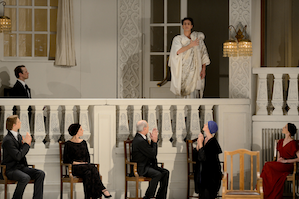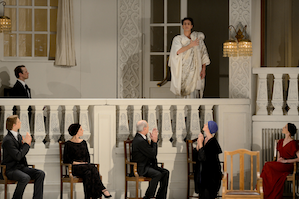
Nijinsky, John Neumeier’s full-length spectacular inspired by the seminal dancer, choreographer, and tragic figure of the 20th century, has arrived in San Francisco 13 years after its premiere. No point mourning that lost time. Just hasten over to the War Memorial Opera House and take it all in. The San Francisco Ballet is hosting the Hamburg Ballet, where the Milwaukee-born Neumeier, who began poring over Vaslav Nijinsky’s biography “before puberty,” as he puts it, is marking his 40th anniversary as Hamburg’s artistic director. He’s created many other ballets, including last year’s SFB hit The Little Mermaid, but Nijinsky’s explosive, searing essence lets us know that it’s the one closest to Neumeier’s heart.
Nijinsky begins and ends with the end of Nijinsky’s career — his final performance on Jan. 19, 1919 in a hotel ballroom in St. Moritz. As the elegant crowd looks on, Nijinsky (Alexandre Riabko) looks back. Other dancers portray characters for which he became famous, in a kind of swirling fantasy; his family, dancers all, dances in as well. His mother, Eleonora Bereda and his father, Thomas Nijinsky, a pair of dancers; his wife, Romola (Hélène Bouchet), in red; his sister the choreographer Bronislava Nijinska (Patricia Tichy), his mentally disturbed dancer brother Stanislaw (Aleix Martínez). And, importantly, there is Serge Diaghilev (Carsten Jung), the impresario, Nijinsky’s mentor and lover, who fired Nijinsky after he married Romola, ending his career.

A sense of shape-shifting suffuses the ballet. Nobody remains what he or she seems for very long, except, of course, Nijinsky. In the first act, in fact, even the ballroom seems to melt and slide, as the dance grows more crazed and Nijinsky’s perceptions more skewed. Neumeier has a gift for body expressiveness in individual characters but also in big groups. In the first act, a circling, leaping skein of women, gowned in shades of brilliant orange, helps connect more intimate sequences.
The second act, initially becalmed, gains emotional fervor as it continues. The dancers’ energy and unity, vitality and control cannot be overstated. To the manic mix is added the menace, the intrinsic insanity, of wartime, represented, in the second act, by phalanxes of soldiers, slow-stepping along the backdrop, or forcefully leaping, coats over underwear, in a scene that simultaneously suggests an asylum, the horrors of battle, and Rite of Spring, wherein Nijinsky’s ballet (its choreography has been lost) caused a riot the night of its Paris premiere a century ago. There isn’t, incidentally, a lick of Stravinsky in Nijinsky. The music, beautifully conducted Wednesday by Simon Hewett, includes ballet excerpts from Chopin, Schumann, and Rimsky-Korsakov, as well as acres of scorched-earth Shostakovich, totally in keeping with the percussive anguish of the storyline, as Nijinsky loses more and more of himself. The eloquence of Riabko’s body is a wonder; he is pliant yet forceful to the last moment, when he shrouds himself in red and black cloth — a puzzling conclusion that, I learned later, represented Nijinsky’s final ballet, Wedding with God.
Nijinsky is a tour de force. We’ve taken in Nijinsky’s agonies, but we’ve also experienced a feast of the senses. Both are what Nijinsky was about.
Nijinsky’s own gifts as a dancer were stunningly represented in the work of Alexandr Trusch and Kiran West as Harlequin, Trusch again in Spectre de la Rose, Thiago Bordin, eerily replicating of Nijinsky’s smile in the famous photo as the Golden Slave in Scheherazade. Most crucially, Lloyd Riggins richly fulfilled the character role of the tragic Petrouchka, with Silvia Azzoni, cast in multiple roles, a particular standout as his partner.
Nijinsky has left us but one of his ballets, Afternoon of a Faun. His dancing exists only in photographs (well worth looking at) and commentary, and his dancing career spanned a mere 16 years. He spent more than half his life in mental hospitals and was diagnosed with schizophrenia. By any measure, this was a disastrous loss to the art form. And yet in the ballet Neumeier gives us an entire personality, a figure of passion and grace to add even more humanity to all that panic and despair.
Neumeier designed Nijinsky, using sketches by Leon Bakst and Alexandre Benois, both of the Ballets Russes. With Jeux, Afternoon of a Faun, Carnaval, Petrouchka, Scheherazade, Les Sylphides, and Spectre de la Rose, Neumeier skillfully intermingles those designs, the choreography, especially that by Fokine; historic, iconic photos, and contemporary performances. Cleverly, Neumeier gives us some choreography and imagery from the era, makes some up, and lets our hearts and minds fill in some more.
In all, Nijinsky is a tour de force. We’ve taken in Nijinsky’s agonies, but we’ve also experienced a feast of the senses. Both are what Nijinsky was about.

